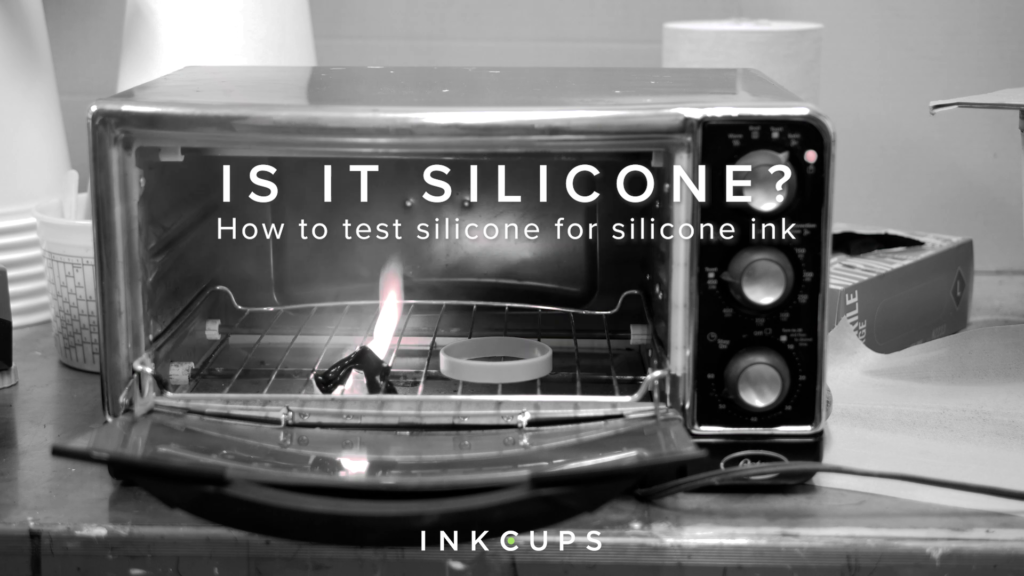
When silicone printing, it is important to properly identify the substrate you are printing on. If the substrate isn’t silicone, the silicone ink won’t adhere. Here are a few ways you can test your products today!
Cant see the video? Watch it on YouTube: https://youtu.be/anMQD0sI-Vs
Steve: Hey, what’s up guys? I’m Steve from Inkcups and I’m coming to you from our ink mixing lab from our Inkcups HQ facility and today we are going to be doing all sorts of stuff with silicone. So we’re gonna do some testing on it to show you how if your product is actually made out of silicone. Now, there’s a lot of imitation silicone materials out there. It might feel like silicone, it might look like silicone, but it’s not.
Well, were going to be printing with silicone ink. and that means If the product isn’t silicone it’s not going to stick to it. You’re not going to get good adhesion and it’s going to scratch right off as soon as you try to. The other part is heat resistance. Silicone can withstand higher temperatures than most other materials so the silicone ink printing process requires you to heat up the print to cure it. Now, if your product isn’t made of true silicone it might burn or melt or damage the part in some way and we don’t want that to happen.
So let’s get to it! I’m gonna grab John and we’ll get printing.
I’m here with John our ink mixologist here at Inkcups and we’re gonna perform the first test which is just a simple adhesion test on your silicone product. Now, you can only do this if you have silicone ink on-hand. So what we’re gonna do is just a basic print, cure, and then adhesion test to see if the ink scratches off or not. So theoretically if the item isn’t made out of silicone the ink should scratch right off.
Alright, John lets get to it!
Now we have our print station set up and we are going to apply a little bit of silicone ink to each product.
Now we have our oven heated to 225 degrees and we’re going to put both pieces in for 7 minutes.
As you can see the silicone product held up quite well. This other imitation silicone, however, does not hold up. Now, why is that? Let’s ask Joe our Expert.
Joe: The only thing that actually sticks to silicone is silicone itself. So the silicone ink isn’t really ink per se, its actually liquid silicone. So once it’s properly cured it actually becomes part of the silicone completely different than what we’re used to in terms of solvent-based pad printing.
Silicone ink is not solvent-based ink. It will remain wet until heat-cured because, in fact, all it is is liquid silicone with a catalyst added. Just like you would if you were making a silicone printing pad. It is the same material.
Steve: Alright so the next test a little bit more fun, we get to actually burn something. So as you know silicone can withstand temperatures up to 600 degrees F. Anything else will distort or burn when exposed to that kind of heat. We’re gonna stick these two items in an oven at over 400 degrees and we’re going to see what happens.
It’s always important to wear safety goggles and heat resistant gloves when you’re working with high temperatures like this so always remember to be safe.
As you can see here the imitation silicone did not hold up well to the heat. I’d say this is a clear indicator of what is silicone and what’s not silicone.
Joe: Silicone can withstand temperatures upwards of 600 degrees F without deforming or melting or getting soft. Other soft materials like TPE will eventually break down and melt at lower temperatures.
Steve: Alright, the last test we’re going to perform today is going to be a direct flame test right onto the silicone products. So what we’re gonna do is apply the blue part of the flame directly to the part. Now what you should notice is two things, 1. it shouldn’t catch fire, it shouldn’t stay lit, it should extinguish itself immediately, the other thing you’ll notice is if it is a silicone it will leave a white ash type of look on the product and we’ll show you what it will look like in just a sec. So let’s get to it!
Joe: If you were doing a burn test for silicone under a lighter, pure silicone will leave a white ash and self extinguish if a flame occurs. Other materials like TPE will actually catch fire and continue to stay lit until the product is melted.
Well, there you have it, folks. 3 test methods you can use to test if your product is silicone or not. Now if you don’t feel like doing these methods in house, you can always contact Inkcups. We offer free adhesion testing on a wide variety of products. You just send them in and we will tell you which ink works best on your product.
Thanks for watching it. I hope you learned something today. Please like and subscribe to our channel. We often post videos about various testing methodologies and printing technology that you might find useful. Please comment below if you have any ideas for future videos you might want us to do. Thank you.
Back to Blog Home
Add Your Comment